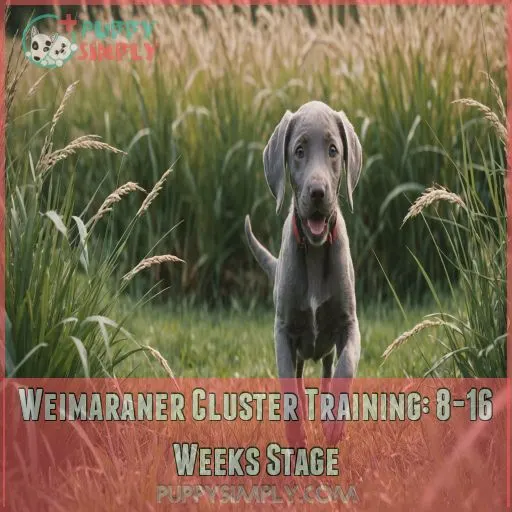This site is supported by our readers. We may earn a commission, at no cost to you, if you purchase through links.

Start early, focusing on socialization from 3-14 weeks. It’s the perfect time for new experiences—think of it as puppy preschool! As they grow, manage their fear periods with a calm routine and lots of reassurance.
By six months, your Weimaraner’s ready for advanced skills like polite play and leash manners. It’s all about patience and consistency. Ready to explore deeper into crafting a perfectly polished Weimaraner companion? Stick around for more tail-wagging tips!
Table Of Contents
- Key Takeaways
- Foundation for a Well-Trained Weimaraner
- Socialization: the Key to Weimaraner Confidence
- Understanding and Navigating Weimaraner Fear Periods
- Weimaraner Cluster Training: 8-16 Weeks Stage
- Weimaraner Cluster Training: 6 Months Stage
- Weimaraner Cluster Training: One Year Milestone
- Addressing Weimaraner-Specific Training Challenges
- Frequently Asked Questions (FAQs)
- Are Weimaraners difficult to train?
- How to discipline a Weimaraner?
- What are the behavioral issues of a Weimaraner?
- What age do Weimaraners slow down?
- How do Weimaraners respond to complex training commands?
- Should Weimaraners be trained in group settings?
- How to balance exercise and training schedules?
- What is the role of mental stimulation in training?
- Are specific tools recommended for Weimaraner training?
- Conclusion
Key Takeaways
- Start training your Weimaraner early with socialization, as it’s your puppy’s golden ticket to becoming a well-adjusted dog. Think of this stage as puppy preschool, where every playdate and new sound builds their confidence and prevents future behavioral issues.
- Create a cozy environment with a balance of love and structure. A mix of gentle pets and clear house rules helps your Weimaraner feel safe and know its boundaries, like when you know the couch is for sitting, not snacking.
- Embrace positive reinforcement as your training best friend. Rewarding good behavior with treats and praise turns commands into opportunities for tail-wagging celebrations. Keep your cues consistent, and before long, your pup will be keen to show off their skills.
- Understand and manage those fear periods, much like navigating a toddler’s mood swings. Stay calm, maintain routines, and use positive experiences to help your Weimaraner turn their superhero-like senses from overwhelmed to well-rounded courage.
Foundation for a Well-Trained Weimaraner
Want to raise a well-behaved Weimaraner?
You’re in for a treat!
Laying a solid foundation early on is the key to success,
and we’ll show you how to create the perfect environment for your pup to thrive.
Start Early: Crucial First Months
Time’s ticking! Your Weimaraner puppy’s first months are the golden opportunity for shaping their future.
Start early to build a rock-solid foundation of trust and communication.
Here’s why it’s important:
- Prevents behavioral issues
- Easier than correcting bad habits later
- Sets the stage for positive reinforcement
- Builds confidence and curiosity
- Creates a lifelong bond
Create Safe and Loving Environment
You’ve laid the groundwork; now let’s build a loving home for your Weimaraner pup.
Create a cozy den with a crate.
Set up safe play zones.
Shower them with gentle pets.
It’s puppy paradise time!
Establish Clear Structure and Boundaries
With a loving environment set, it’s time to lay down the law—gently, of course! Clear structure helps your Weimaraner pup thrive. Here’s how to establish boundaries:
House rules and routines are essential for a well-behaved pup.
- Set consistent house rules
- Create a daily routine
- Designate safe spaces
- Start crate training early
- Enforce boundaries calmly
Positive Reinforcement Training Techniques
Positive reinforcement is the golden key to boosting your Weimaraner’s potential.
Use treats, praise, and well-timed clicks to reward good behavior.
Consistency is key – stick to your commands and celebrate small wins.
Your pup will soon become keen to please!
Building Trust and Communication
Trust is the cornerstone of your Weimaraner’s training journey.
Establish clear boundaries while fostering positive interactions.
Learn to read your pup’s body language and use consistent commands.
This early bonding sets the stage for a lifelong partnership.
Socialization: the Key to Weimaraner Confidence
You’re about to start a really important journey with your Weimaraner puppy: socialization.
From 3 to 14 weeks old, you’ll be shaping your pup’s confidence and future behavior through carefully planned exposures to the world around them.
Critical Socialization Period (3-14 Weeks)
The critical socialization period is your golden ticket to raising a confident Weimaraner.
From 3 to 14 weeks, your pup’s brain is like a sponge, soaking up experiences that’ll shape their future. Don’t miss this window!
- Puppy playdates for social skills
- Gentle handling to build trust
- Exposure to household sounds
- Positive car ride experiences
- Introduction to different surfaces
Exposure to Various Stimuli
Diving into sensory enrichment, expose your Weimaraner pup to a world of wonder.
From squeaky toys to rustling leaves, each new experience builds confidence.
Introduce novel objects, textures, and sounds to create a well-rounded, fear-free furry friend.
Breeder’s Role in Early Socialization
Beyond exposing puppies to various stimuli, responsible breeders play a pivotal role in shaping your Weimaraner’s social skills.
They’ll implement puppy handling routines, enrich environments, and facilitate litter socialization.
You’ll benefit from their expertise in temperament testing and exposure protocols.
Continuing Socialization at Home
Once your Weimaraner pup’s home, keep the socialization party going!
Invite friends over, introduce novel objects, and expose your furry friend to household sounds.
Practice grooming and let them explore diverse textures.
It’s a daily adventure in puppy confidence-building!
Developing a Well-Adjusted Puppy
You’ve laid the groundwork at home, now let’s shape your Weimaraner into a well-adjusted pup.
Here’s your recipe for success:
- Serve up a buffet of experiences
- Sprinkle in plenty of positive reinforcement
- Stir gently with consistent handling
Your confident canine companion is just around the corner!
Understanding and Navigating Weimaraner Fear Periods
You’ve mastered the basics, but now your Weimaraner’s acting like a scaredy-cat.
Don’t worry – your pup’s just going through a fear period, a normal part of growing up.
That’ll help shape their personality.
First Fear Period (8-11 Weeks)
Your Weimaraner’s confidence journey takes an unexpected turn at 8-11 weeks.
Suddenly, they’re on high alert! This first fear period is like puppy puberty – everything’s new and potentially scary.
Don’t worry, we’ll navigate it together, through this puppy puberty.
Second Fear Period (6-14 Months)
- Stay calm and collected
- Maintain consistent training
- Boost confidence through positive experiences
- Adjust expectations during this phase
Your pup’s just growing up!
Increased Sensitivity to Surroundings
During this phase, your Weimaraner’s senses go into overdrive.
They’re like little detectives, hyper-aware of every sight, sound, and smell.
It’s as if they’ve suddenly gotten superhero powers – but sometimes those powers overwhelm them.
Managing Anxiety During Fear Periods
When your Weimaraner puppy gets anxious during fear periods, don’t panic! Stay calm and patient.
Here are three strategies to help manage their anxiety:
- Create a safe space
- Use gentle reassurance
- Maintain normal routines
Positive Experiences to Counter Fear
Feeling like your pup’s walking on eggshells?
Fear-busting adventures can help!
Use reward-based desensitization and confidence-building games.
Try gradual exposure techniques and positive association exercises to turn worried wags into joyful leaps of faith.
Weimaraner Cluster Training: 8-16 Weeks Stage
During the 8-16 weeks stage, it’s your chance to socialize your curious Weimaraner in various environments, from bustling city streets to quiet parks.
With every upbeat vet visit and happy interaction, you’re setting the stage for a confident, well-adjusted pup that might just think those car rides are the best thing since sliced kibble.
Socialization in Various Environments
Imagine this: a tiny explorer discovering new textures and unfamiliar sounds in novel environments.
It’s like opening a treasure chest of experiences!
Surround your Weimaraner puppy with diverse people and various public spaces to foster confidence.
You’ll witness curiosity bloom beautifully.
Exposure to Traffic and Public Spaces
Braving urban bike paths and city sidewalks helps your young Weimaraner become a savvy city dweller.
Introduce public transportation and pedestrian crossings slowly, turning noise acclimation into a cool new adventure.
Your pup will navigate bustling streets like an old pro!
Positive Associations With New Experiences
How can you make certain your Weimaraner pup adapts smoothly to new environments? Use positive reinforcement impacts: 1. Reward-based introductions make scary things fun.
- Fear-reduction strategies ease anxiety.
- Encouraging exploration turns the unfamiliar into adventure.
Familiarization With Vet Visits and Handling
While making outings a positive experience, don’t forget about vet visits!
Start with gentle handling at home to ease your Weimaraner’s nerves.
Desensitization training turns anxieties into tail wags.
Think: extra treats, calming words, and friendly vet interactions.
Success guaranteed!
Weimaraner Cluster Training: 6 Months Stage
At the 6-month stage, your Weimaraner is ready to refine its social skills and start understanding the not-so-fun concept of space boundaries—just like us trying to respect the invisible line in the grocery store queue!
By focusing on polite play, recall response, and crate training, you’ll help your furry friend develop confidence and impulse control, all while reinforcing housetraining progress.
Teaching Polite Play and Bite Inhibition
Nurturing puppy play includes teaching gentle play and redirecting bites with safe toys.
Offer chew alternatives, transforming potential nip-fests into friendly play sessions.
With patience, you’ll soon be singing, "Who’s a good boy?" without any surprise nibbles!
Housetraining Progress and Reinforcement
So you’ve got playtime under control, but housetraining accidents still pop up occasionally, right?
Don’t sweat it!
Use positive reinforcement and consistency.
Every success deserves a reward.
With patience, even the most stubborn pooch learns quickly!
Introducing Alone Time and Crate Training
Now’s the time to get your Weimaraner comfy with alone time. Crate training can ease separation anxiety – just introduce it gradually, pairing it with treats and praise. Your pup will learn to love their cozy den.
- Start with short periods of alone time, rewarding calm behavior.
- Gradually increase duration, making the crate a positive experience.
- Use puzzle toys and chews to keep your pup occupied.
- Be patient – it may take time, but your Weim will get there.
Developing Strong Recall Response
Six months into training, your Weimaraner can master the "come" command with consistent practice.
Recall training tips include using rewards for recall and practicing in new places.
Keep it fun—even with distractions, persistence pays!
Advancing Impulse Control Exercises
Does your Weimaraner struggle with impulse control?
Introduce training games like "leave it" using food puzzles.
Focus on distractions and enrichment activities to teach delayed gratification.
Weimaraner Cluster Training: One Year Milestone
At the one-year milestone, you’ll find yourself delighted as your Weimaraner is ready to refine their obedience skills like a pro.
With some dedication, a bit of patience, and the occasional bribe (treats work wonders!), you’ll be introducing advanced commands and tuning their training to suit their individual quirks.
Mastering Basic Obedience Commands
By one year, your Weimaraner should have mastered basic commands like sit, stay, come, and down. Consistent practice and positive reinforcement are key to cementing these essential skills.
Refining Loose Leash Walking Skills
When you’re refining leash-pulling solutions, picture you and your Weimaraner as partners on a dance floor.
Here’s a quick guide:
- Use proper equipment.
- Practice heel training.
- Overcome walking distractions.
- Embrace positive reinforcement.
Strengthening Drop It and Leave It
Mastering "drop it" and "leave it" commands with your Weimaraner can seem like a wild ride, but staying persistent amid distractions keeps them safe.
Make it fun!
Reward their curiosity, and soon they’ll drop like pros!
Tailoring Training to Individual Needs
Just like fitting a square peg into a round hole, dog training isn’t one-size-fits-all.
Age-specific training and personality traits should be factored in, understanding breed characteristics.
Customize techniques and methods to your Weimaraner’s individual goals and environmental factors for best results.
Introducing Advanced Commands and Challenges
By now, your Weimaraner’s a pro at the basics – time to kick it up a notch!
Explore advanced commands like agility, scent work, and retrieving to challenge their brilliant mind.
The sky’s the limit!
Addressing Weimaraner-Specific Training Challenges
Training your Weimaraner can be as challenging as keeping a toddler in a candy store, but everyone can succeed with some patience and persistence.
Through understanding their specific challenges—like separation anxiety and their love for chewing—you’ll help your dog become a well-behaved and happy companion.
Managing Separation Anxiety
Separation anxiety in Weimaraners can feel like tightrope walking, but there’s hope! Here are four steps: 1. Crate training builds security.
- Identify anxiety triggers.
- Establish calming routines.
- Explore medication options with your vet.
Preventing and Correcting Destructive Chewing
Preventing destructive chewing is key to mastering a calm household.
Choose the right chew toys and teething solutions for your teething Husky pup.
Redirect chewing with a bitter spray.
Crate training keeps those mischievous gnawing impulses in check!
| Technique | Description |
|---|---|
| Chew Toy Selection | Provide safe options. |
| Teething Solutions | Soothe their gums. |
| Redirect Chewing | Use sprays to deter. |
Controlling Excessive Barking and Jumping
Curb excessive barking by identifying triggers and redirecting that energy into calmer commands. Tame jumping by teaching "off" cues and providing ample outlets for your Weimaraner’s boundless enthusiasm.
Leash Training for Strong-Willed Weimaraners
Jumping directly into leash training your strong-willed Weimaraner, grab a no-pull harness.
Use consistent environments, practicing leash handling techniques.
Positive reinforcement works wonders—reward compliance with treats—they’ll soon walk like a pro!
Maintaining Training Consistency Long-Term
Keeping your Weimaraner’s training on track takes dedication, but the payoff is a well-behaved pup.
Stick to a routine, use motivating rewards, and maintain consistency in commands.
With time and patience, your training will become second nature.
Frequently Asked Questions (FAQs)
Are Weimaraners difficult to train?
Training Weimaraners isn’t a walk in the park, but with the right tools and consistency, you’ll have a well-mannered companion.
Focus on socialization, exercise, and positive reinforcement to harness their intelligence and energy effectively.
How to discipline a Weimaraner?
Oh sure, a talking to will surely solve everything—dogs, like teenagers, don’t ever ignore these discussions.
Seriously though, use positive reinforcement.
Redirect unwanted behavior with treats and praise, avoiding punishment.
Patience and consistency are key.
What are the behavioral issues of a Weimaraner?
Weimaraners may face separation anxiety, leash pulling, and chewing woes.
They’re spirited, highly social creatures needing structure.
Without it, they might dance to their mischief tune.
Start early with training and socialization to keep them well-behaved.
What age do Weimaraners slow down?
You’ll notice your Weimaraner starts slowing down around 5-7 years old.
Don’t worry, they’re just trading in their boundless energy for a more relaxed, couch-potato vibe.
Just be sure to keep them active and engaged as they age.
How do Weimaraners respond to complex training commands?
When tackling complex commands, your intelligent Weimaraner thrives on clicker training, breaking tasks into bite-sized chunks.
They might test your patience occasionally, but persistence and positive reinforcement will have them performing like rock stars!
Keep it consistent.
Should Weimaraners be trained in group settings?
Training in a group setting can be a great idea for your Weimaraner, as it encourages socialization and can make learning more fun.
Just make sure they’re comfortable and the environment is positive and structured.
How to balance exercise and training schedules?
Strike a balance by making exercise part of your training routine!
Tire them out with a quick run, then teach commands.
It’s like a mental workout for them and a win-win for you—trained and exhausted!
What is the role of mental stimulation in training?
Ah, mental stimulation – the secret sauce that keeps your pup’s noggin’ in tip-top shape!
Engage that brilliant brain with puzzles, tricks, and playtime.
Watch your four-legged friend blossom into a well-rounded, happy hound.
Are specific tools recommended for Weimaraner training?
Equip yourself with tools like clickers and treat pouches; they’re your magic wand for training Weimaraners!
These tools, along with a consistent routine, transform your training sessions into a symphony of progress and wagging tails.
Conclusion
Did you know 90% of a dog’s brain develops by six months? That’s why following the Weimaraner cluster training stages is your ticket to success.
By sticking to these training steps, you’ll nurture a confident and well-behaved companion.













